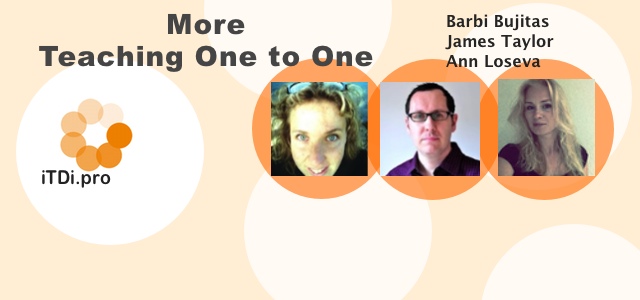
Teaching Little Kiddies One-to-One
– Barbi Bujitas
“Life is like cooking. The cookery book doesn’t always help.” – Gorest Fump
At least for me. As for cooking, I’m impossible. I never have all the ingredients I need for that recipe in the glossy cookery book. And I don’t have time to go shopping, or I don’t think it’s worth all the trouble. I get the inspiration, follow the principles of cooking and simply cook something similar to that recipe. The point is cooking and eating.
Like teaching young learners one at a time, following books is not manageable. I never have the ingredients. That particular student just hates the hedgehogs in the book. He can’t stand that action song! Engagement is missing. Or something. Always.
I’ve got used to the habit of constantly modifying and testing the recipe, tailoring it to what I have. I need to become a skillful cook who can make a great dinner from what I find in the pantry. No cookie cutter approach has ever worked for me with one-to-one students either. If I want them to like the lessons and learn something at the same time, I must keep to the pantry rule. I say don’t try and force coursebooks, syllabi, lesson plans, or other recipes.
Oh, no, there IS one book
A book on teaching one-to-one that I seem to live by, surprisingly is titled Teaching One To One by Tim Murphy, first published in 1991. I read it in my last year at college, then I forgot all about it, taught 15 years mostly one-to-one, now I’ve read it again and I’m shocked to admit that I’ve been following it all the time! Either the book made its way under my skin, or I’ve come to the very same conclusions and principles. This is not a recipe book, go read it and talk to other teachers who do one-to-one. There’s a wiki for such teachers, and a Facebook group.


Student-teacher / Parent-Teacher
Perhaps my being an impossible cook as well as an impossible teacher lies in my personality. I can’t be serious, that is. There is a ocean of difference between being a school/group teacher and a one-to-one instructor. I am a learning buddy, not the trace of authority. I need to make my students learn something and I have to be an entertaining mate – otherwise they won’t want to come. I focus on what’s good in our lessons for them. You just can’t count on their extrinsic motivation: if they have some, it fades away in seconds.
Parents won’t treat me like a regular teacher either. Again, I mostly work in my living room, how am I an authority figure there? Okay, the kid loves the lessons, wants to come in the summer holiday and on Christmas Day, but for the parents you must provide some evidence of learning to avoid feeding the suspicion that we only have fun. If it were a school, this evidence could be a coursebook or a pile of completed worksheets. But then you kill the magic that makes that child want to come. All my students have a blog documenting what we do in the lessons, explaining to the parents what and why, offering feedback fundamentally different from grades, stickers or smileys.
(If you want to have a look at them, contact me.)
Course/syllabus design, lesson planning
Something I forgot about quite early is that teaching one-to-one requires a peculiar approach to course design and lesson planning. It’s increasingly true about young learners. Just consider this: do they have a uniform cognitive/social/emotional/moral/physical development design? How accurate is it? Now you see … I don’t think I can’t exclude these factors when deciding on lesson content. I dare say some of these sometimes can be better met in one-to-one.


Some of my students who have taught me tricks that work
G. She was about 4 when she decided to ask her mom to find her a private English teacher while they were busy making lángos in the kitchen. Now she’s 6. She always has a toy along, with its own story and personality. She plays roles, loves drawing pictures of these characters in her life. I accept that these things engage her more than anything else, she labels pretty much anything else ‘babyish’. So I’m game. (Though I manage to feed her a Peppa Pig story every now and then, some children’s songs also win sometimes.)
She is of course not proficient enough to be able to talk about/in her world in English, so what I usually do is I record a quick video of the character, sometimes we create a story and record that. Everything is documented on her blog, she sees it frequently. She picks up a lot of English. She often grabs her mum’s phone to record similar videos in Hungarian with occasional English words. This is very similar to what Tim Murphey wrote about in Teaching One to One — only not tape recordings but videos.
Á. A first grader, he loves making things. We make something or experiment, do some fancy science thing. The project boy. He’s not friends with simple video projects, he has the urge to make something tangible. I either have something up my sleeve for him, more often than not he likes it, or we have an entirely unplugged lesson stuffed with scissors, glue, Pinterest, origami, toilet rolls, what not…In the latter case we first decide on the theme, following the seasons or using whatever happened to him. Then go to Pinterest and look around. He decides what to make, we read it (=I read it and he sees what I read, which is good as he sees that one function of reading is to get info), we check if we have all the necessary ingredients or think about how we can adjust the product to our resources or vice versa. And off we go. (Eye-hand-brain coordination, planning, re-planning, time management, cooperation, etc.) The whole time I collect the potential learning outcome in my head. (This may sound bad, but I have to post-plan and I am alert for every little language element that can be taught.)While doing the ‘dirty job’ (cutting, tearing, coloring) I usually find a song that is related to the product, sometimes earworms that get stuck in his brain better than a nursery song sang over and over.So I make sure I take photos and videos (here’s a spooky one) to post on his blog, my browser history and tablet are immense help, I also prepare a list of new words in Quizlet with pictures (mostly for the parents).
A. A. lives in stories too, she’s 6, a kindergartener. She’s a cat or a princess, an owl or a mama frog. We create digital stories on my tablet. I love this! She actually acts out the story, when she’s stuck I add an element so it is quite collaborative, we laugh like hell and document the stories with the help of a collage app, and later I turn them into videos. There are everyday situations in the story (shopping, telling someone off, asking a favor, etc.) which I try to follow up in later before the new story. It isn’t easy though, in a whole new world.
M. He gave me an idea of recording a digital story in the student’s voice, sentence by sentence. The end product is something they can watch again and again, listening to their own voice, hopefully learning from themselves. The whole thing started when M. was 20 minutes late and came in, apologizing (in Hungarian) “Hi Barbi, sorry for being late, I had a bit of a technical problem.”
As I managed to unlearn what I’d read 15 years ago (Murpey, 1991), first I thought it was a sort of cheating. Now I’m relieved it’s not, it’s valid, written about in a proper paper book! Go and read that book, really.
Finally, a short list of some things you can do in one to one but not in the big classroom
- get rid of babyish stuff
- make nursery poetry look cool
- create tasks tailored to that one student
- talk a lot, fast and naturally in L2: it is very easy to check if your young learner understands you or not,
- give loads of (comprehensible) input.
- use game design fitting your learner’s preferences.
- make a mess: cook, use science experiments, eat, use their own toys.
- have a vacuum cleaner and wet wipes ready at all times.
- let their initiatives evolve.
- let them go with the flow of their own stories
- train them to achieve goals.
- consider available resources, adjust things, keep time, prioritize, just do projects
- build a human partnership (instead of the traditional teacher:students=Tom:Jerries setting)
Connect with Barbi and other iTDi Associates, Mentors, and Faculty by joining iTDi Community. Sign Up For A Free iTDi Account to create your profile and get immediate access to our social forums and trial lessons from our English For Teachers and Teacher Development courses.





